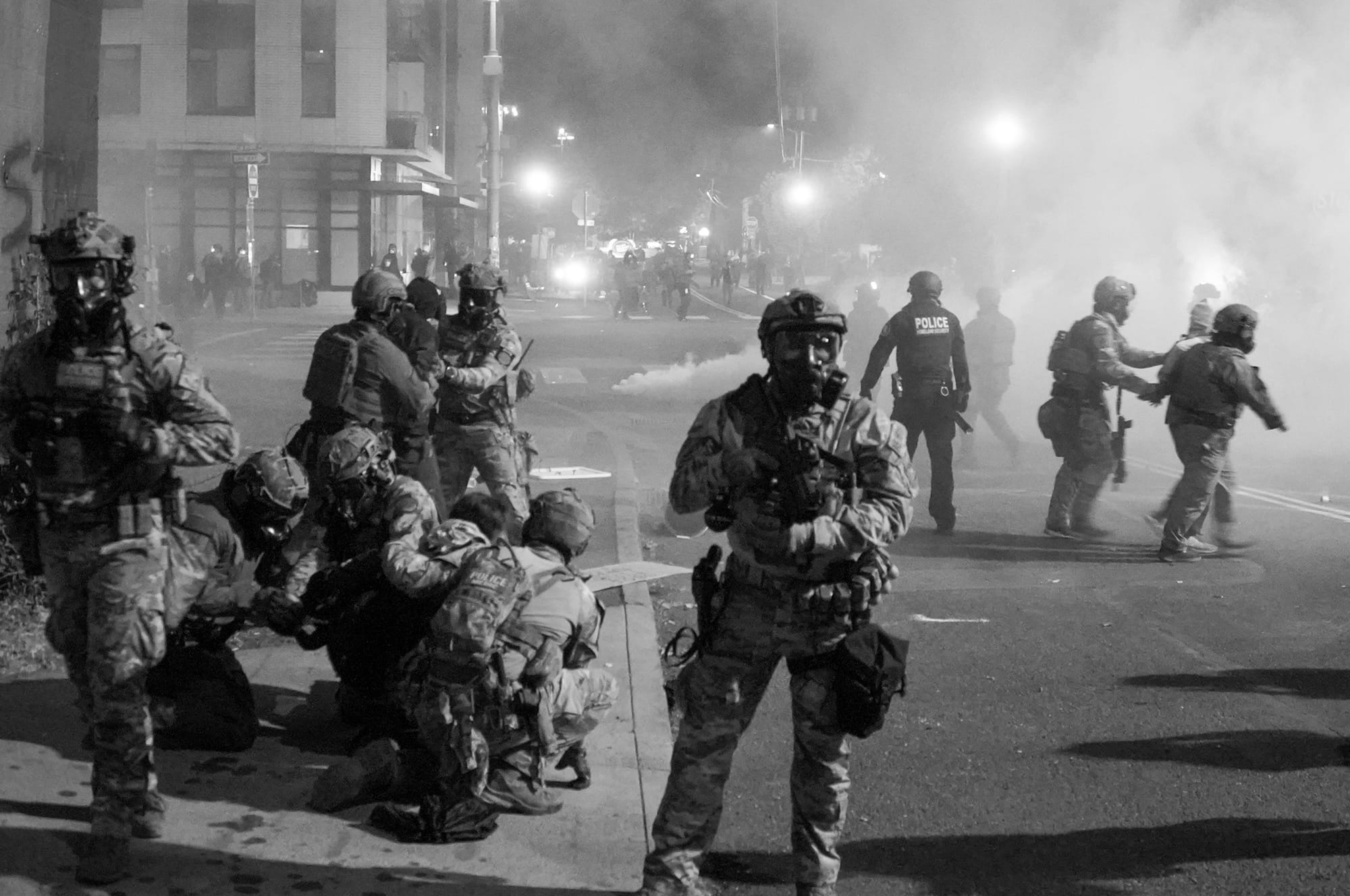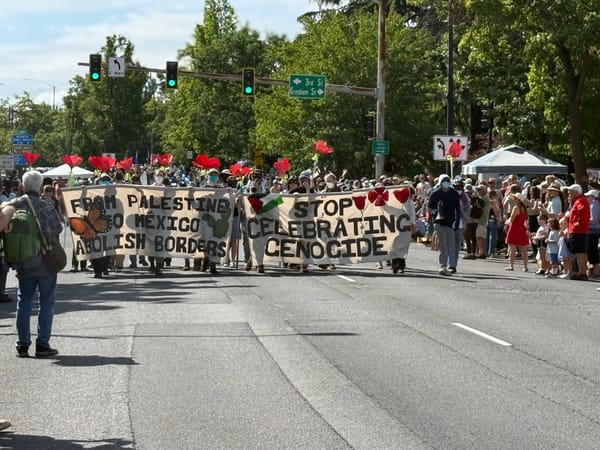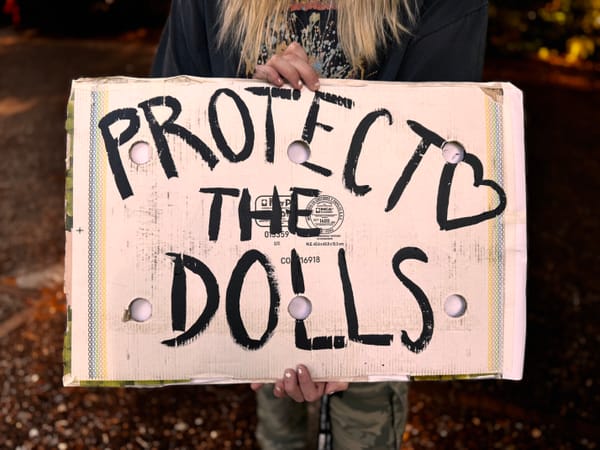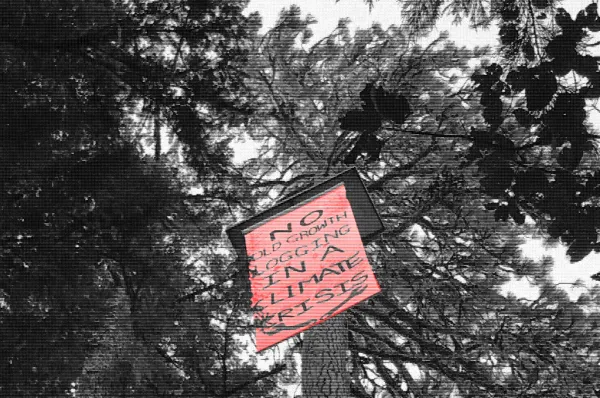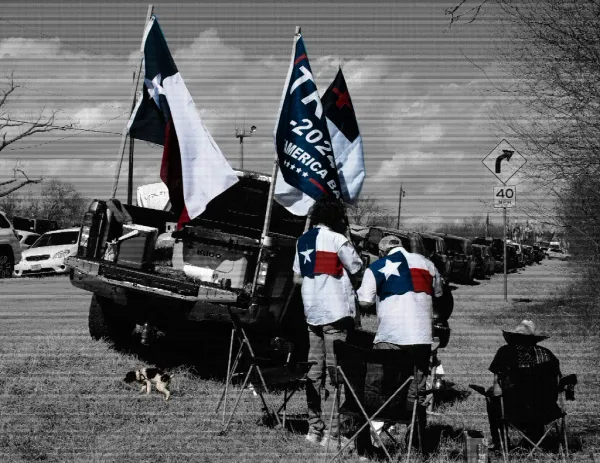How Surveillance Tech is Being Used to ID and Charge Portland Protesters
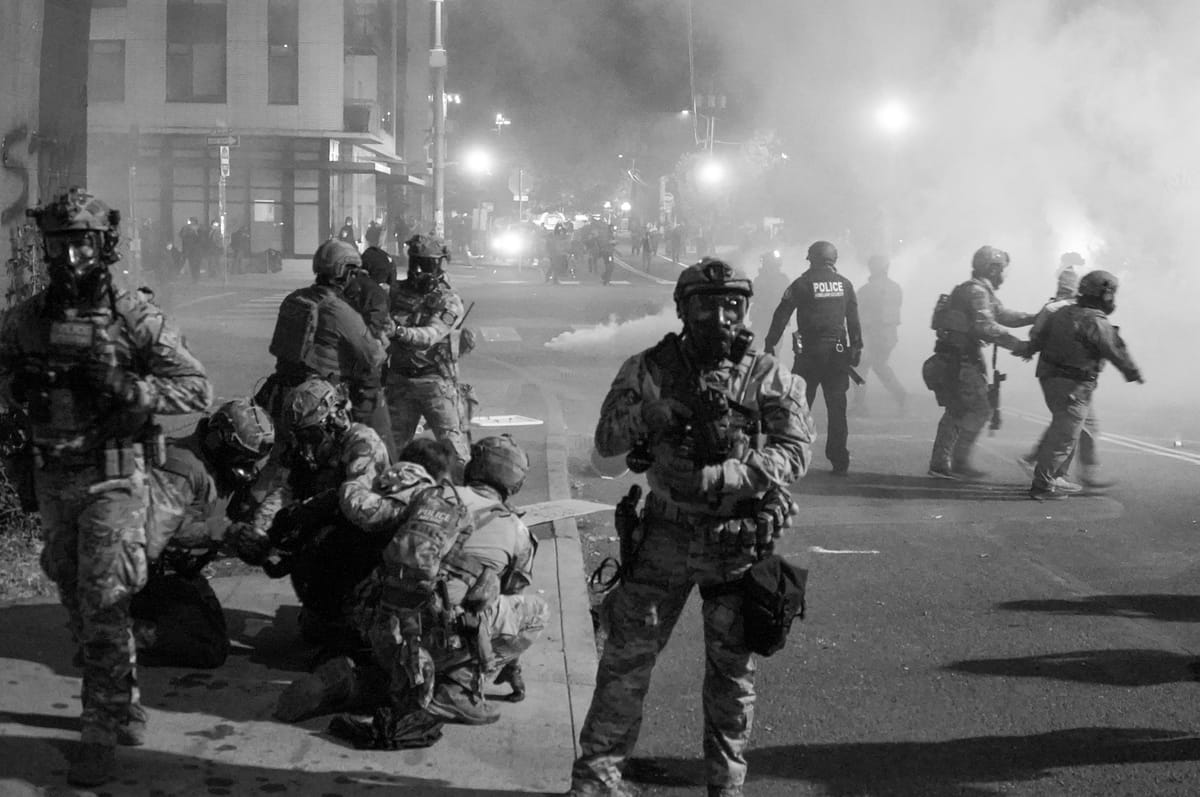
Surveillance technology is helping criminalize resistance.
On July 24, a criminal complaint was filed in federal court. Less than 24 hours later, FBI agents raided the defendant’s home in Portland, OR while they had rifles drawn on them and their housemates. By Monday, July 28, the defendant stood in federal court for their first appearance. According to the complaint, the FBI alleges that the individual was present at a protest at Portland’s ICE facility on June 14, 2025. That evening, demonstrators had broken off from the larger “No Kings Day” rally and marched to the ICE field office. Hours later, the Portland Police Bureau declared a riot- setting off another wave of repression in a city already familiar with the consequences of dissent.
On paper, it's about rocks and windows. In reality, it’s about crushing dissent.
A newly released FBI affidavit shows how the U.S. government is identifying and charging protesters who resisted ICE, not based on eyewitness accounts or direct evidence, but by sifting through hours of surveillance footage and narrowing suspects down by what they wore. In this case, a gas mask with bright pink filters.
Let’s be clear, this isn’t about “keeping ICE employees safe” or protecting some obnoxiously reinforced building. It’s about retaliating against the people who dared to show up, mask up, and say: Fuck ICE.
From Gas Masks to Federal Charges
On June 14, 2025, federal authorities claim that someone threw a rock at a federal agent at the Portland ICE field office, where people have been protesting for nearly two months. The feds are calling it “assault on a federal officer.” But what they’re actually doing is criminalizing defiance, a political crackdown dressed in the language of law enforcement.
The FBI affidavit reads like a dystopian surveillance report: Subject 1 (“S1”) wore a long-sleeved black shirt with the sleeves rolled up, a gas mask with bright pink filters, a visible tattoo on one forearm, and a bracelet on their left wrist. For the feds, that was enough.
Agents zoomed in on footage to identify tattoos, bracelets, shirt patterns, and even a blue cloth sticking out of a back pocket. No face was needed. Just patterns, posture, and color recognition. “Full-face masks with bright pink filter cups were far less common,” the affidavit states.
That’s not probable cause. That’s pattern-matching turned into criminal evidence. Surveillance enhanced by AI and weaponized by the state.
“Assault” or Self-Defense?
Let’s not pretend this is neutral ground; the ICE building is a violent site. Every day, people are processed for deportation. People are being kidnapped. Families are separated. Migrants are targeted, surveilled, caged, and disappeared. In the affidavit, the feds allege that the defendant threw a rock that injured a federal agent. But framing that act as “assault” ignores the broader reality: this facility enacts systemic violence daily. What they call assault, many would call self-defense. Resistance to state violence is not an attack; it’s survival. This isn’t about “justice,” but rather making an example of people who dare to resist white supremacist state violence.
Surveillance as a Weapon: Gas Masks, AI, and Dissent
The affidavit is loaded with language that reads more like a surveillance tech brochure than a legal document:
“I enlarged the images... I noted a tattoo... a bracelet... a grid pattern... a blue cloth...”
This is biometric tracking without the biometrics. It’s algorithmic identification based on non-unique visual data: clothing, accessories, posture, movement.
This same playbook was used during the 2020 uprisings, where facial recognition, AI tools, and OSINT (open-source intelligence) were used to identify Black Lives Matter protesters, many of whom were later charged federally for property damage or “civil disorder.”
Now the tools are sharper, faster, and fully integrated into federal policing. The affidavit doesn’t name the tech, but it’s screaming machine learning and pattern analysis.
Press Photo to Facial Recognition
The net tightened six days later. The federal agent allegedly injured by the rock submitted a photo he had found in an OregonLive news article to the FBI that appears to show S1 helping an injured protester. In the photo, S1's gas mask was lifted, and their face was visible. All it took was a split second for the photographer to capture that shot.
That single image was the primary material then used by federal agents and fed into facial recognition software.
The affidavit goes on to state that this photo found in the OregonLive article was put through a "commercially available facial recognition software" that they used during a "demonstration" for the United States Attorney's Office. The software provided the FBI with 30 possible matches sourced from various public databases to use for comparison. One of the hits came back with a result from a Reed College SmugMug album, showing a person who federal authorities claim to have a similar build to S1, in addition to a tattoo that is identical to the one seen in the OregonLive photo. Another hit came from a private Instagram account, which had a name attached to it along with a picture of the account user wearing a shirt that said "Reed" on it, and a bio that read "Reed CS 2023," helping confirm ties to the college.
From there, it escalated quickly. The unnamed Special Agent then contacted Gary Granger, the Director of Community Safety at Reed College, who provided federal agents with college alumni information about S1 without any warrant or subpoena (Granger has since been put on administrative leave as they await a "formal investigation," as the Director's actions violated school protocols). The Special Agent then proceeded to request and access records from the Oregon Department of Motor Vehicles and found that a license was issued to someone who had the same name and address as the person identified in the college alumni information. From here, federal agents went on to conduct a location check of the address listed in both the alumni and DMV records, and used binoculars and took photos to identify the distinctive tattoo and silver bracelet on S1's left arm as S1 was standing on the porch of their home.
It wasn’t one piece of evidence; it was the full surveillance stack.
Surveillance Stack: What the Playbook Looks Like
This is the surveillance stack in action- the full playbook of repression. It starts with high-resolution, zoom-capable cameras mounted on buildings and vehicles, capturing everything in real-time. Then comes AI-powered pattern recognition: tattoos, clothing, body movement, even the color of your shoelaces can become identifiers. Facial recognition tools, often commercial systems like Clearview AI or PimEyes, are layered on top, linking footage to faces scraped from social media or online records. Once a potential match is made, agents cross-reference databases: Instagram posts, college yearbooks, DMV photos, and data broker files. Finally, they show up in the real world- staking out homes, taking long-lens photos, and building a case one breadcrumb at a time. It's not just surveillance, it's a system designed to criminalize dissent from every angle.
This is what the digital police state looks like in motion.
Portland: The Blueprint
Conservative media have pushed the narrative that anarchists have taken over Portland since Trump’s 2016 election, using it to justify state-sanctioned violence, surveillance, criminal charges, and federal crackdowns. That narrative escalated again in 2019, when antifascists mobilized against a far-right demonstration organized by Patriot Prayer and the Proud Boys. After the clashes broke out, Trump tweeted that “major consideration is being given to naming ANTIFA an ‘ORGANIZATION OF TERROR’,” while Texas Senator Ted Cruz called for federal prosecution of antifascists. These weren’t just rhetorical outbursts; they were a preview of the escalated repression to come. They were the prelude to 2020’s Operation Diligent Valor.
None of this is new. In Portland, during the 2020 George Floyd uprisings, the feds beta-tested much of this.
The tactics being used against anti-ICE protesters today are direct descendants of strategies deployed during the 2020 George Floyd uprisings, particularly in Portland, Oregon, which became a federal testing ground for high-tech repression. Over 100 consecutive nights of protest against police brutality and racial injustice were met not only with tear gas and rubber bullets, but also with a surge of federal agents deployed under Operation Diligent Valor.
This Trump-era initiative blurred the line between local and national policing. Launched by the Department of Homeland Security in July 2020, the operation flooded Portland with agents from Customs and Border Protection (CBP), Immigration and Customs Enforcement (ICE), the U.S. Marshals Service, the Border Patrol Tactical Unit (BORTAC), and even agents from the Bureau of Alcohol, Tobacco, Firearms and Explosives (ATF). This was on top of the already active and violent presence from local police (State Troopers and the Portland Police Bureau). At the time, many operated out of unmarked vehicles and wore no identifying insignia, abducting protesters off the street without explanation or warrants. Videos showed masked officers dragging individuals blocks away from demonstrations, detaining them without charges, and releasing them hours later without any documentation. These tactics weren’t about public safety. They were about sending a message: We are watching you. We will identify you. And we can disappear you.
Five years later, that same playbook is still in use. On top of all the people who are catching both state and federal charges, at the recent protests at Portland’s ICE facility, federal agents have repeated the same “catch and release” tactics- harassing and assaulting demonstrators, identifying individuals, and then letting them go without even a citation or explanation. More often than not, it is less about actual arrests and more about intimidation and collecting information: a psychological operation meant to fracture solidarity, scare people into silence, and expand the feds' intel. And just like in 2020, the primary effect of federal agents hasn't been to protect federal property, but rather to escalate violence.
Alongside this physical repression came a wave of surveillance and OSINT that pushed the bounds of legality. Protesters were identified not through eyewitness testimony or direct confrontation, but via meticulous tracking of their online and consumer behavior.
In one case reported by The Verge, federal agents identified a protester by tracing a distinctive T-shirt she wore to a protest back to a custom Etsy purchase. They linked her Etsy username to a public review she left on the site, then connected it to her LinkedIn profile, which listed her full name and place of employment. From a single image, agents built a data trail that resulted in federal charges.
In another case in August 2020, a teenager was charged with arson after federal authorities claimed that he had thrown a Molotov cocktail at the federal courthouse building in Portland. Prosecutors state that it was the teen's grandmother who helped them make the case, as she had posted a review of a vest she had purchased for him to wear as a means of protection against rubber bullets at protests. His grandmother stated as much in her review, and even included a picture of her grandson wearing the vest at a protest. Federal authorities say that they used this picture in tandem with surveillance footage to ID him,
This strategy of cross-platform surveillance, combining commercial databases, social media, and pattern recognition, is now routine. As detailed by the Electronic Frontier Foundation, federal agencies have expanded their surveillance capabilities with tools like Clearview AI (which scrapes billions of public images without consent for facial recognition) and data brokers who sell location, purchase, and demographic information to law enforcement.
These programs worked in tandem with Operation Legend, another DOJ initiative launched in mid-2020 under the guise of reducing violent crime in cities like Chicago, Albuquerque, and Kansas City. While its public branding emphasized traditional criminal enforcement on a "law and order" campaign, its real function was to bring federal repression into cities where protests were ongoing. Operation Legend flooded cities with federal agents, quietly shifted protest-related prosecutions to federal court (where sentences are often harsher), and normalized the use of surveillance-enhanced evidence like phone metadata, social media scraping, and face-matching software.
Operation Legend blurred the line between federal and local policing. Under the guise of "crime reduction," it sent federal agents into protest-heavy cities to crush and criminalize dissent, filed charges using surveillance tech and OSINT, and essentially paved the way for mass facial recognition in protest response. What we're seeing now is just a continuation that is refined, normalized, and unchallenged.
Tools of the Surveillance State
When federal affidavits refer to “commercially available facial recognition software,” they’re often pointing to a powerful (and largely unregulated) set of tools used to track, monitor, and criminalize dissent. Clearview AI, for example, scrapes billions of photos from social media and sells access to police departments across the U.S., building searchable databases. Amazon’s Rekognition software was once quietly used by ICE, until public backlash and civil liberties concerns led to a temporary pause.
Public-facing tools like PimEyes allow anyone to reverse-image search faces across the internet. And government-grade platforms like Microsoft Azure Face and Face++ offer high-accuracy facial recognition, often deployed in policing, border enforcement, and surveillance operations. These systems don’t just recognize faces, they map networks, track movement, flag clothing and gear, and archive biometric breadcrumbs across time. Once you’re in the system, you don’t get to opt out.
This Isn’t About Safety. It’s About Control.
The goal isn’t to protect anyone; it’s to break the will of those who dare to fight back. They want you to flinch at the thought of resistance. To see your gas mask as a liability. To imagine a federal indictment every time you lace up your boots. But fear is how they win, and isolation is how they enforce it. We fight it by building something they can’t predict, can’t infiltrate, and can’t crush: networks rooted in care, rage, and refusal. This system survives on surveillance. But solidarity makes us ungovernable.
So mask up. Look out for each other. And never let them scare you into silence.
Resources:
Electronic Frontier Foundation:
- Know Your Rights
- Privacy Badger (learn about tracking and how companies spy on you)
- Surveillance Self Defense
- Atlas of Surveillance (learn what surveillance tech is being used near you)
- Cover Your Tracks (learn about browser tracking and how to protect yourself online)
- Street Level Surveillance (field guide on law enforcement surveillance tools and strategies)
- Resisting the Menace of Face Recognition
No Trace Project
- Surveillance and Operational Security Zine Database
Searchable database of zines, texts, and other media dealing with surveillance and operational security. - Threat Library
a breakdown and classification of actions that can be used against us. Its purpose is to help you think through what mitigations to take in a particular project and to navigate resources that go into more depth on these topics. In other words, it helps you arrive at appropriate operational security for your threat model. - Ears and Eyes
Searchable database of cases of physical surveillance devices (microphones, cameras, location trackers) hidden by law enforcement and intelligence agencies to surveil people or groups engaged in subversive activities.
Security Culture & OPSEC Zines
- What is Security Culture? – CrimethInc.
Intro to why security culture matters and how to minimize risk, vet trust, and protect each other. - A Base to Stand On – No Trace Project
Breaks down OPSEC vs security culture. - Confidence. Courage. Connection. Trust. A Proposal for Security Culture - Sprout Distro
Blocing Up & Anonymity Zines
- Blocs, Black and Otherwise – Crimethinc
How and why people form black blocs, what blocing up looks like, and its role in mass actions. - Blocing Up - Sprout Distro
Tips on anonymity and using bloc. - Fashion Tips for the Brave - Crimethinc
- Mask Up: How & Why - It's Going Down
Digital Security & Surveillance Resistance
- How to Defend Against Police Surveillance at Protests - ACLU
- End-to-End Encryption 101 - Crimethinc
- Your Phone is a Cop: An OpSec/InfoSec Primer for the Dystopian Present - It's Going Down
- Surveillance Self-Defense International - EFF
- Minimising your online trail - Privacy International
- Guides to collect your data from apps - Privacy International
- Green Scared? - Counter-Surveillance Resource Center
Further Reading:
- Unregulated Police Face Recognition in America - The Perpetual Line-Up
- Podcast about Clearview AI - EFF
- Beating Back the Rise of Law Enforcement’s Digital Surveillance of Protestors: 2017 in Review - EFF
- Security Zine Collection - Sprout Distro
- To the International Anarchist Movement: Three Security Proposals - No Trace Project
EFF
- Surveillance Technology
- Biometrics
- Anonymity
- AI/Machine Learning
- Cell Tracking
- End-to-End Encryption
- Face Surveillance
- Location Privacy
- Mobile Devices
- Social Networks
- Surveillance Drones
